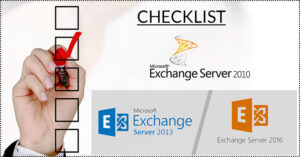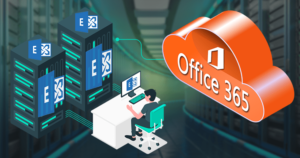Exchange Server is the most influential platform globally that empowers users to handle emails, calendars, contacts, etc. Mounting is a regular but tricky process for IT admin when moving to a different server, recovering from system or server errors and many more. If you want a deeper insight into how to mount an Exchange database on different servers, this blog is an excellent match for you.
Here, we will discuss the complete process of mounting the Exchange database using different approaches. You will know two traditional solutions in this blog to mount Exchange database (EDB) files without struggle.
Mount database meaning is simple; it is a process responsible for making the EDB’s data available to users. Additionally, users can easily access their Exchange database items, including email messages, calendar entries, tasks, etc.
And when it comes to mounting the exchange database on different servers! It simply means restoring the exchange database to make database items accessible to users on another server where you are going to mount the EDB file.
Finest methods to mount Exchange database (EDB) files
Users can step forward with three solutions: two manual and one automated EDB Repair tool. This section will give users a step-by-step guide to mount the Exchange database on different servers using manual and professional approaches. No matter whether you are looking to mount an Exchange database on a different server in 2016, 2019, or 2013, the Exchange admin centre and PowerShell commands are two common manual ways to look into mounting a database.
1. Mount Exchange database 2013, 2016, or 2019 using the EAC
To mount the Exchange database 2013, 2016, or 2019, users can make the usage of the Exchange Admin Center (EAC). The steps are given below; follow them to mount or restore the database on a different server.
- Go to your browser and log in to the Exchange Admin Center (EAC) with your admin account credentials.
- After that, select the Servers and click the Databases option.
- Now, you will see the list of all databases.
- Then, find the database you want to mount on a different server and select it.
- Next, tap the three dots (More) from the right panel and hit the Mount button.
- A dialogue box will appear to ask permission to mount the Exchange database on a different server. Kindly, click the Yes button to start mounting the database.
This simple procedure will allow users to mount the Exchange database on different servers. Also, please keep in mind that this solution can only process a single Exchange database in one go.
2. Using PowerShell to mount the Exchange database in all editions
Users can also utilize the PowerShell commands in the Exchange Management Shell to mount the Exchange database on a different server. The upcoming instructions will guide users on restoring or mounting the databases on the different Exchange Servers in 2013, 2016 or 2019.
- First of all, make sure that the other Exchange Server is installed correctly.
- Then, copy and paste the Exchange database files (.edb or.log) from the old server to the new database folder location; the default location is as follows:
C:\Program Files\Microsoft\Exchange Server\V15\Mailbox\<DatabaseName>
- Thereafter, open the Exchange Management Shell by searching it from the Start menu.
- If necessary, kindly run the command below to create a new mailbox database on the new server.
New-MailboxDatabase -Name "<NewDatabaseName>" -EdbFilePath "C:\Program Files\Microsoft\Exchange Server\V15\Mailbox\<DatabaseName>.edb" -LogFolderPath "C:\Program Files\Microsoft\Exchange Server\V15\Mailbox"- After that, mount the Exchange database on a different server following the below-shared command.
Mount-Database -Identity "<DatabaseName>"Note: Type the database file name you copied instead of <DatabaseName>.
- Check the Mount status by running the command:
Get-MailboxDatabase | Format-Table Name, Mounted- It will show ‘True’ after running the above command if the mounting process gets completed.
Note: Performing these methods carefully and having a prior backup of the EDB file is recommended. Otherwise, you may lose essential items from the Exchange database.
Using these solutions, users can mount the Exchange database on different servers. If they fail to mount the Exchange database, the file might have a corruption issue. Moreover, mounting the database through the above solutions is risky, as there is a chance of data loss. So, users should also think of looking into the backup of the Exchange EDB file. For this, we have an alternative option: a professional EDB to PST Converter Tool. It is fully laced with advanced features and facilities to overcome mounting database issues like corrupted databases. Let us discuss briefly about this astounding tool.
Robust tool to recover or backup corrupt EDB! The Shoviv EDB to PST Converter
If you need to keep a backup of the Exchange database or are willing to recover the corrupted database, the Shoviv EDB to PST Converter Tool is exactly what you need. This software smoothly repairs the corrupted EDB files and saves them in PST file format. It will help users mount Exchange database on the different server without any issues, by keeping a backup of the database. This tool also takes care of the folder hierarchy and meta properties when processing the Exchange EDB files.
Users can also export their EDB file data to EML, MSG, HTML and other file formats. Users will also find the option to move the EDB files directly into the Live Exchange Server and Office 365 mailboxes. Furthermore, the tool comes without any restrictions on processing large-sized EDB files or a large number of files at once. Its user interface is easy to understand, so anyone can quickly process EDB files from Exchange 2010, 2013, 2016, or 2019.
Final Remarks
We have done a brief talk on the solutions in the above write-up, Exchange Admin Center and PowerShell commands to mount the Exchange database on the different servers. Also, we have shared the Shoviv EDB to PST Converter Tool to export EDB file data for securing data and avoiding unexpected disruptions while mounting the EDB file. Every user can handle this tool, as there is not much need for technical understanding to use it. This tool also works for every Exchange database file from any Exchange versions, including 2007, 2010, 2013, 2016, and 2019. Users can try its free trial version to check how well this tool works and freely process up to 50 items from each folder of the EDB file.
- How to Import or Export Contacts in Any Outlook Version? - March 31, 2025
- Understand Groups & Permissions on a SharePoint Site - March 21, 2025
- My Outlook Emails are Stuck in the Outbox! What’s Going On? - March 12, 2025


